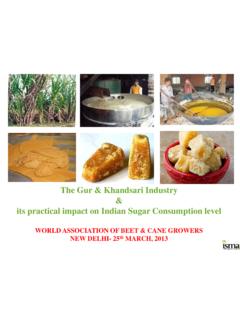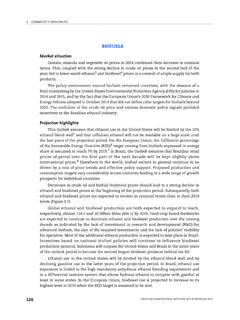Transcription of BIOFUELS Market situation - Food and Agriculture ...
1 3. COMMODITY SNAPSHOTSOECD-FAO AGRICULTURAL OUTLOOK 2016-2025 OECD/FAO 2016116 BIOFUELSM arket situationSeveral political changes concerning biofuel markets were finalised in the courseof 2015. In Brazil, the taxation system was amended to favour hydrous ethanol rather thangasohol3and the mandatory anhydrous ethanol blending ratio was increased from 25% to27%. In the European Union, revisions to the Renewable Energy Directive (RED) and to theFuel Quality Directive were adopted. A 7% cap was introduced on renewable energy comingfrom food and feed crops in the transport sector by 2020. After a long delay, the USEnvironmental Protection Agency s (EPA) final rulemaking for the years 2014-16 was issuedin November 2015.
2 The mandates specified are higher than those proposed earlier in theyear, though still considerably lower than the initial levels proposed in ethanol4and biodiesel5prices continued to decrease in nominal terms in 2015due to weak crude oil and biofuel feedstock prices. Demand for bioenergy in thetransportation sector was mostly driven by blending mandates in major economies and bysustained fuel use around the highlightsInternational prices of ethanol and biodiesel are expected to recover in nominal termsover the outlook period, given developments in crude oil markets and the recovery of pricesof biofuel feedstock (Figure ). Global ethanol production is expected to expand modestlyfrom 116 Bln L in 2015 to Bln L by 2025.
3 Half of this growth will originate from expansion of global biodiesel production will be driven by policies in place inthe United States, Argentina, Brazil and Indonesia, and to a lesser extent the fulfilment ofthe RED target in the European Union. It is expected to increase from 31 Bln L in 2015 Bln L by 2025. Advanced BIOFUELS are not expected to take off over the the United States, thisOutlookassumes that the 10% ethanol blend wall6willcontinue to limit growth in ethanol use, that biodiesel use will expand due to a strongeradvanced mandate and that cellulosic ethanol will not be available on a large scale. Thecellulosic mandate will be mostly met with renewable compressed natural gas andrenewable liquefied natural gas.
4 In the European Union, the proportion of total transportenergy accounted for by BIOFUELS , including double counting for sustainable BIOFUELS isexpected to reach by remainder of the 10% RED target will be met from otherrenewable energy sources such as electric Brazil, it is assumed that prices will remain favourable to hydrous ethanol userather than gasohol and thus a sustained demand for ethanol, mostly met by domesticproduction, will prevail over the outlook period. Indonesian biodiesel production will beused mainly to meet domestic mandate-driven demand. For India, the new policies aimingat compensating sugar mills for high sugar prices will encourage ethanol production in the world, development of the comparatively minor BIOFUELS marketsdepends on a mix of effective policy support and price trends, leading to mixed prospectsacross COMMODITY SNAPSHOTSOECD-FAO AGRICULTURAL OUTLOOK 2016-2025 OECD/FAO 2016117 Biofuel trade will remain limited.
5 It is expected that ethanol exports will mostlyoriginate from the United States where the blend wall limits further increases in domesticdemand, and that biodiesel trade will be mostly directed from Argentina tothe United States in order to meet the biodiesel and advanced mandates. Indonesianexports of biodiesel are expected to remain marginal given high tariffs imposed byimporting future evolution of energy markets as well as possible policy changes are keyuncertainties attached to theOutlookfor biofuel markets over the next decade. However,given recent policy decisions, uncertainties concerning the future of biofuel marketsshould ease somewhat, at least over the expanded BIOFUELS chapter is available biofuel pricesNote:Ethanol: wholesale price, US, Omaha.
6 Biodiesel: Producer price, Germany, net of biodiesel tariff and energy :OECD/FAO (2016), OECD-FAO Agricultural Outlook ,OECD Agriculture statistics(database), 2 priceReal priceUSD/hlEthanolBiodieselBIOFUELS 1 OECD-FAO AGRICULTURAL OUTLOOK 2016 OECD:FAO 2016 BIOFUELS Main assumptions Since the early 2000s, the development of global biofuel markets has been driven by policies fostering their production and use. Policies were initially motivated by a combination of factors, including the view that biofuel use would improve energy security and reduce greenhouse gas emissions (GHG). Government support for the biofuel industry takes the form of blending mandates, exemptions from taxes applied to corresponding petroleum fuels, and investment support.
7 Biofuel markets are also affected by sustainability criteria, fuel quality standards, and import tariffs on ethanol and biodiesel. The projections presented in this Outlook are based on a set of assumptions concerning the evolution of biofuel policies around the world in the medium term. In the United States, the Energy Independence and Security Act (EISA) of 2007 defined the Renewable Fuel Standard programme known as Under this programme, EISA established four quantitative annual mandates up to 2022: the total and advanced mandates that require fuels to achieve respectively at least a 20% and a 50% GHG reduction as well as the biodiesel and the cellulosic mandates that are nested within the advanced mandate.
8 The Environmental Protection Agency (EPA) provided on an annual basis the minimum quantities for each of the four classes of BIOFUELS required. The EPA final rulemaking for the years 2014-16 was issued in November 2015. It waives part of the initial levels proposed in 2007 for the total, the advanced and the cellulosic mandates based on the fact that the production capacity for cellulosic ethanol has lagged well behind the mandated quantities specified in EISA and that the ethanol blend wall2 issue represents a circumstance that warrants a reduction in the mandated volumes under the inadequate domestic supply general waiver provision in the RFS2.
9 The mandates specified are higher than the proposals made in November 2013 and earlier in 2015. Similar assumptions have been used to derive a level for the mandates in 2017. This Outlook assumes from 2018 onwards that the total mandate should remain close to its 2017 level. By 2022, the total mandate should be 50% lower than what was initially specified in RFS2 (Figure ). This is due to several factors including decreasing gasoline use, although low crude oil prices support gasoline use in the short term, limitations in the expansion of domestic ethanol use related to the blend wall issue and the difficulties encountered in supplying E15 to US consumers as well as limited development of the flex-fuel vehicle fleet.
10 The advanced mandate is assumed to expand over the outlook period whereas, given lower gasoline use prospects and the restricted availability of blends going behind the 10% blend wall, the implied maize based ethanol mandate is assumed to decline after 2018. It is also assumed that the biodiesel mandate will rise. Biodiesel like sugarcane based ethanol qualifies for the advanced mandate. Argentinean soybean oil based biodiesel is certified to meet the biodiesel and advanced mandates. The need for sugarcane based ethanol imports to fill the advanced gap3 is expected to be decreasing and limited over the outlook period.
















![Index [www.tongaat.co.za]](/cache/preview/f/7/7/5/c/d/4/1/thumb-f775cd41d646a3d64d3ce917aaad62e5.jpg)
